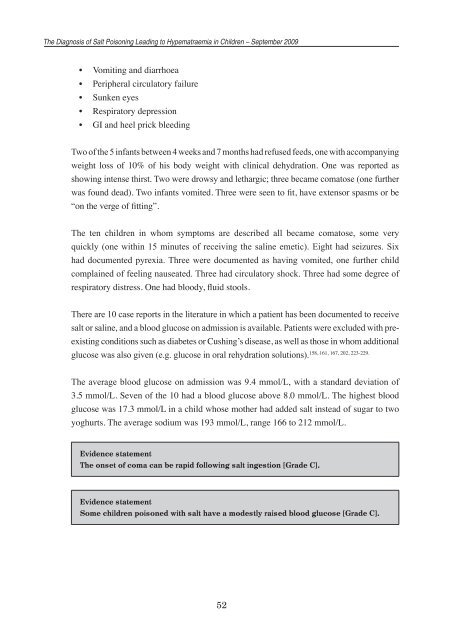The differential diagnosis of hypernatraemia in children, with ...
The differential diagnosis of hypernatraemia in children, with ...
The differential diagnosis of hypernatraemia in children, with ...
You also want an ePaper? Increase the reach of your titles
YUMPU automatically turns print PDFs into web optimized ePapers that Google loves.
<strong>The</strong> Diagnosis <strong>of</strong> Salt Poison<strong>in</strong>g Lead<strong>in</strong>g to Hypematraemia <strong>in</strong> Children – September 2009<br />
• Vomit<strong>in</strong>g and diarrhoea<br />
• Peripheral circulatory failure<br />
• Sunken eyes<br />
• Respiratory depression<br />
• GI and heel prick bleed<strong>in</strong>g<br />
Two <strong>of</strong> the 5 <strong>in</strong>fants between 4 weeks and 7 months had refused feeds, one <strong>with</strong> accompany<strong>in</strong>g<br />
weight loss <strong>of</strong> 10% <strong>of</strong> his body weight <strong>with</strong> cl<strong>in</strong>ical dehydration. One was reported as<br />
show<strong>in</strong>g <strong>in</strong>tense thirst. Two were drowsy and lethargic; three became comatose (one further<br />
was found dead). Two <strong>in</strong>fants vomited. Three were seen to fit, have extensor spasms or be<br />
“on the verge <strong>of</strong> fitt<strong>in</strong>g”.<br />
<strong>The</strong> ten <strong>children</strong> <strong>in</strong> whom symptoms are described all became comatose, some very<br />
quickly (one <strong>with</strong><strong>in</strong> 15 m<strong>in</strong>utes <strong>of</strong> receiv<strong>in</strong>g the sal<strong>in</strong>e emetic). Eight had seizures. Six<br />
had documented pyrexia. Three were documented as hav<strong>in</strong>g vomited, one further child<br />
compla<strong>in</strong>ed <strong>of</strong> feel<strong>in</strong>g nauseated. Three had circulatory shock. Three had some degree <strong>of</strong><br />
respiratory distress. One had bloody, fluid stools.<br />
<strong>The</strong>re are 10 case reports <strong>in</strong> the literature <strong>in</strong> which a patient has been documented to receive<br />
salt or sal<strong>in</strong>e, and a blood glucose on admission is available. Patients were excluded <strong>with</strong> preexist<strong>in</strong>g<br />
conditions such as diabetes or Cush<strong>in</strong>g’s disease, as well as those <strong>in</strong> whom additional<br />
158, 161, 167, 202, 223-229.<br />
glucose was also given (e.g. glucose <strong>in</strong> oral rehydration solutions).<br />
<strong>The</strong> average blood glucose on admission was 9.4 mmol/L, <strong>with</strong> a standard deviation <strong>of</strong><br />
3.5 mmol/L. Seven <strong>of</strong> the 10 had a blood glucose above 8.0 mmol/L. <strong>The</strong> highest blood<br />
glucose was 17.3 mmol/L <strong>in</strong> a child whose mother had added salt <strong>in</strong>stead <strong>of</strong> sugar to two<br />
yoghurts. <strong>The</strong> average sodium was 193 mmol/L, range 166 to 212 mmol/L.<br />
Evidence statement<br />
<strong>The</strong> onset <strong>of</strong> coma can be rapid follow<strong>in</strong>g salt <strong>in</strong>gestion [Grade C].<br />
Evidence statement<br />
Some <strong>children</strong> poisoned <strong>with</strong> salt have a modestly raised blood glucose [Grade C].<br />
52

















